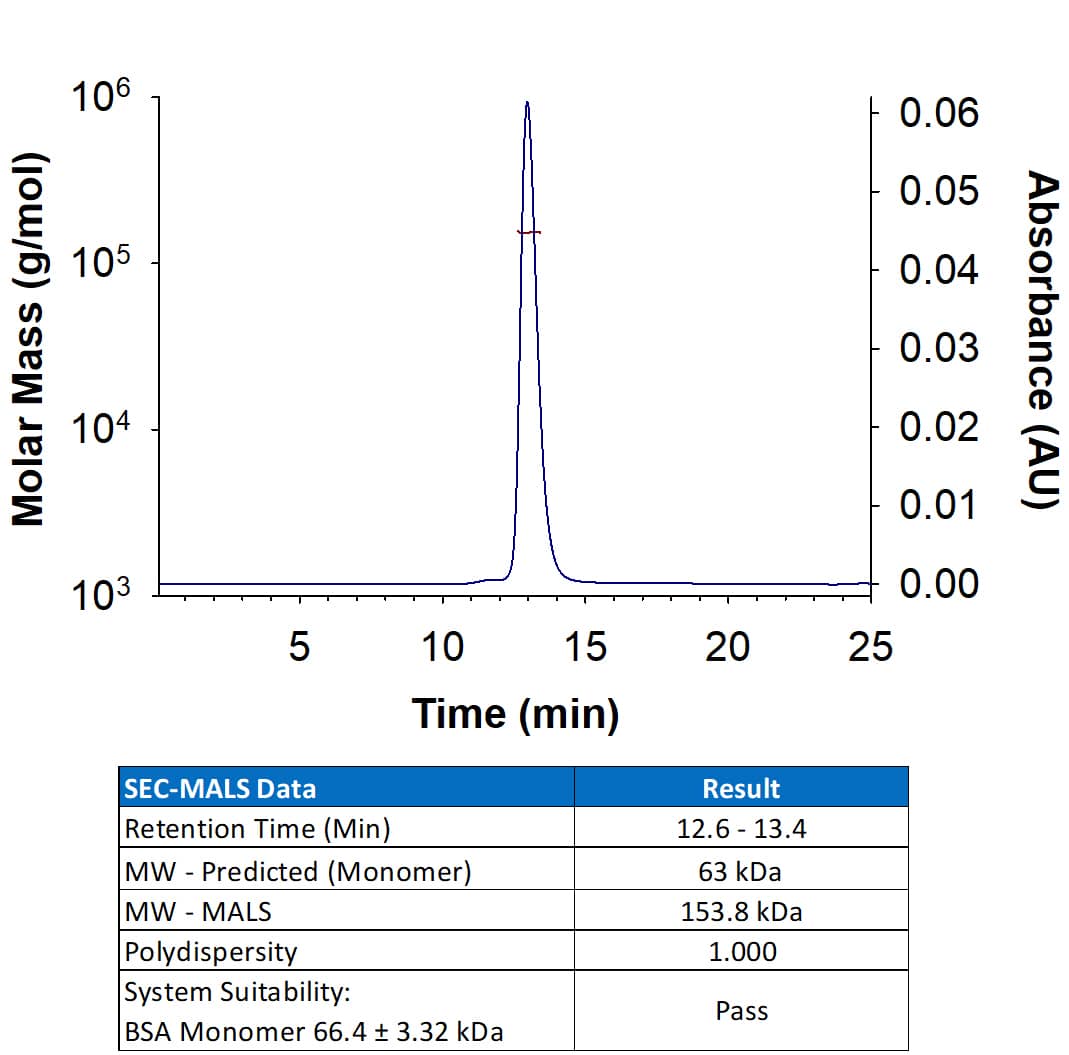Siglec-9 Products
Siglecs are I-type (Ig-type) lectins belonging to the Ig superfamily. They are characterized by an N-terminal, Ig-like V-type domain that mediates sialic acid binding, followed by varying numbers of Ig-like C2-type domains (2 to 17), a single transmembrane region, and a cytoplasmic tail. The siglecs can be broadly classified into two subgroups: Siglecs-1, -2, and -4, and a Siglec-3/CD33-related subgroup (Siglecs-3, and -5 through -13 in primates) defined by sequence similarity and clustered gene localization. They are widely expressed on hematopoietic cells, often in a cell-type-specific manner, and Siglec-4/MAG is a myelin component in Schwann cells and oligodendrocytes. Their ligands, sialic acids, are negatively charged monosaccharides found on cell-surface glycoproteins and glycolipids. Although Siglec functions continue to be defined, most have intracellular immunoreceptor tyrosine-based inhibitory motifs (ITIM), implicating them in the suppression of immunoreceptor signaling. They may also participate in cell/cell interactions or act as receptors for the entry of viral or bacterial pathogens.
118 results for "Siglec-9" in Products
118 results for "Siglec-9" in Products
Siglec-9 Products
Siglecs are I-type (Ig-type) lectins belonging to the Ig superfamily. They are characterized by an N-terminal, Ig-like V-type domain that mediates sialic acid binding, followed by varying numbers of Ig-like C2-type domains (2 to 17), a single transmembrane region, and a cytoplasmic tail. The siglecs can be broadly classified into two subgroups: Siglecs-1, -2, and -4, and a Siglec-3/CD33-related subgroup (Siglecs-3, and -5 through -13 in primates) defined by sequence similarity and clustered gene localization. They are widely expressed on hematopoietic cells, often in a cell-type-specific manner, and Siglec-4/MAG is a myelin component in Schwann cells and oligodendrocytes. Their ligands, sialic acids, are negatively charged monosaccharides found on cell-surface glycoproteins and glycolipids. Although Siglec functions continue to be defined, most have intracellular immunoreceptor tyrosine-based inhibitory motifs (ITIM), implicating them in the suppression of immunoreceptor signaling. They may also participate in cell/cell interactions or act as receptors for the entry of viral or bacterial pathogens.
Design and order Simple Plex cartridges tailor made to meet your needs with customizable Simple Plex Assay panels for the Ella platform.
| Applications: | Simple Plex |
| Source: | NS0 |
| Accession #: | Q9Y336 |
| Applications: | BA |
Clone 191240 was used by HLDA to establish CD designation
| Reactivity: | Human |
| Details: | Mouse IgG2a Monoclonal Clone #191240 |
| Applications: | WB, Flow, CyTOF-ready, Neut |
| Reactivity: | Human |
| Details: | Goat IgG Polyclonal |
| Applications: | WB, Flow, CyTOF-ready, ICC |
| Reactivity: | Human |
| Details: | Goat IgG Polyclonal |
| Applications: | WB, Flow, ICC |
Clone 191240 was used by HLDA to establish CD designation
| Reactivity: | Human |
| Details: | Mouse IgG2a Monoclonal Clone #191240 |
| Applications: | Flow |
Simple Plex Human Siglec-9 assay kit for use on Ella instrument. Contains cartridge, sample diluent SD13, and wash buffer.
| Applications: | Simple Plex |
Create your custom Simple Plex cartridge for up to 8 targets. Choose from more than 250 targets across multiple species.
| Reactivity: | Canine, Monkey, Bovine, Primate, Equine |
| Details: | Rabbit IgG Polyclonal |
| Applications: | WB |
| Reactivity: | Human, Canine, Monkey |
| Details: | Mouse IgG1 Monoclonal Clone #OTI1D9 |
| Applications: | IHC, WB |
Contains 4 membranes - each spotted in duplicate with 59 different immunoreceptor antibodies
Clone 191240 was used by HLDA to establish CD designation
| Reactivity: | Human |
| Details: | Mouse IgG2a Monoclonal Clone #191240 |
| Applications: | Flow |
| Reactivity: | Human |
| Details: | Goat IgG Polyclonal |
| Applications: | WB, Flow, CyTOF-ready, ICC |
| Reactivity: | Human |
| Details: | Goat IgG Polyclonal |
| Applications: | WB, Flow, CyTOF-ready, ICC |
| Reactivity: | Human, Canine, Monkey |
| Details: | Mouse IgG1 Monoclonal Clone #OTI1D9 |
| Applications: | IHC, WB |
Clone 191240 was used by HLDA to establish CD designation
| Reactivity: | Human |
| Details: | Mouse IgG2a Monoclonal Clone #191240 |
| Applications: | Flow |
Clone 191240 was used by HLDA to establish CD designation
| Reactivity: | Human |
| Details: | Mouse IgG2a Monoclonal Clone #191240 |
| Applications: | Flow |
Analyzed by SEC-MALS
| Source: | HEK293 |
| Accession #: | XP_005590140.2 |
| Applications: | BA |
| Reactivity: | Human |
| Details: | Goat IgG Polyclonal |
| Applications: | WB, Flow, CyTOF-ready, ICC |
| Reactivity: | Human |
| Details: | Goat IgG Polyclonal |
| Applications: | WB, Flow, CyTOF-ready, ICC |
| Reactivity: | Human |
| Details: | Goat IgG Polyclonal |
| Applications: | WB, Flow, CyTOF-ready, ICC |
| Reactivity: | Human |
| Details: | Goat IgG Polyclonal |
| Applications: | WB, Flow, CyTOF-ready, ICC |
| Assay Range: | 62.5 - 4,000 pg/mL |
| Applications: | ELISA |
Clone 191240 was used by HLDA to establish CD designation
| Reactivity: | Human |
| Details: | Mouse IgG2a Monoclonal Clone #191240 |
| Applications: | Flow |
Clone 191240 was used by HLDA to establish CD designation
| Reactivity: | Human |
| Details: | Mouse IgG2a Monoclonal Clone #191240 |
| Applications: | Flow |
Clone 191240 was used by HLDA to establish CD designation
| Reactivity: | Human |
| Details: | Mouse IgG2a Monoclonal Clone #191240 |
| Applications: | Flow |










![Western Blot: Siglec-9 Antibody [NBP2-27070] Western Blot: Siglec-9 Antibody [NBP2-27070]](https://resources.bio-techne.com/images/products/Siglec-9-Antibody-Western-Blot-NBP2-27070-img0002.jpg)
![Western Blot: Siglec-9 Antibody (OTI1D9) [NBP1-47969] Western Blot: Siglec-9 Antibody (OTI1D9) [NBP1-47969]](https://resources.bio-techne.com/images/products/Siglec-9-Antibody-1D9-Western-Blot-NBP1-47969-img0017.jpg)


![Western Blot: Siglec-9 Antibody (OTI1D9)Azide and BSA Free [NBP2-74189] Western Blot: Siglec-9 Antibody (OTI1D9)Azide and BSA Free [NBP2-74189]](https://resources.bio-techne.com/images/products/Siglec-9-Antibody-OTI1D9-Azide-and-BSA-Free-Western-Blot-NBP2-74189-img0002.jpg)



